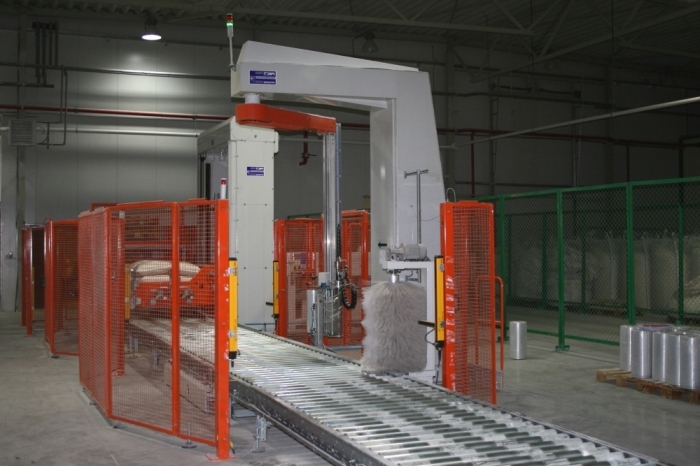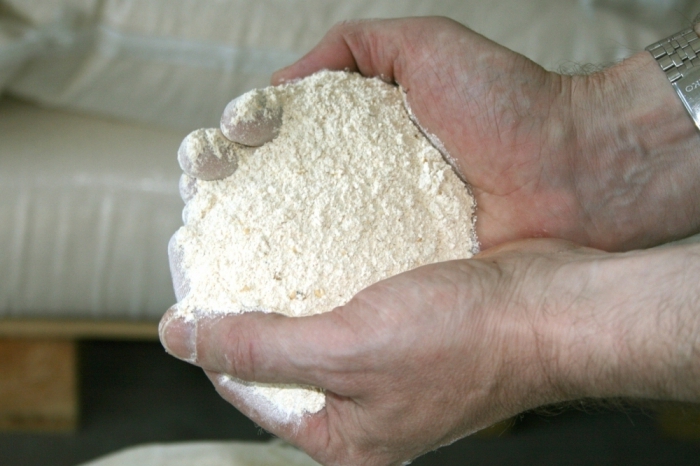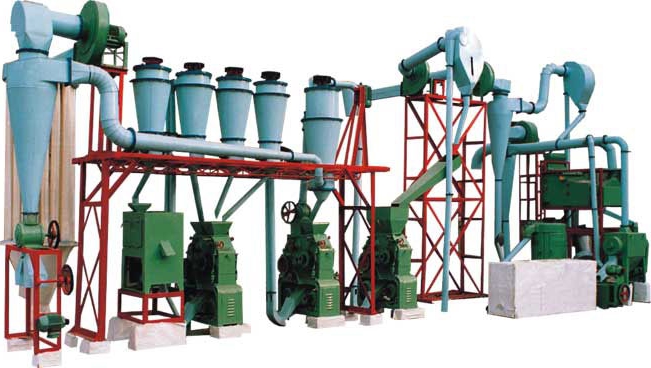It is hardly necessary to once again talk about the popularity of flour products. Almost all of us buy bread, rolls, cookies and other similar products every day. There is a basis for all this - flour. This product of grinding wheat and other crops is in demand always and everywhere.
Let's talk about how to set up our own flour production. This is just the business that, with the proper approach, will be able to bring significant profits. But in the first stages you will have to work almost all day.

Some general information
As noted above, flour can be made from various cereals, such as barley, rice, oats, corn, etc. This gives us a wide choice, so if your region has problems with the supply of wheat, you can use raw materials another grain. At the same time, one should not forget that production will differ slightly depending on the type of raw material selected.
For this simple reason, it is recommended that you first determine the cereals, and only after that purchase a production line. We can say with confidence that Russia has its own raw material base, so most of the products are manufactured here. This suggests that you will be a little easier to start, as there will be no competition from foreign companies.
This business can hardly be attributed to seasonal. This is due to the fact that bread and pasta are perfectly bought, both in winter and in summer. Of course, during the crisis, the consumption of expensive products, such as baking, decreases, but this is not a reason to stop your business. Flour production is a complex technological process that requires quality control at all stages of manufacturing.
If you can make a quality product at the exit, then you will have plenty of buyers. First of all, it’s a bakery. But you, as the future owner of the flour factory, should know that it comes in different qualities. There is a first, second and highest grade. It is advisable that you can produce several. In the best of times, you will be successful in selling top-quality products, and in difficult times, of the second. Let's talk about what the production line consists of, but at the same time we will consider the process itself.
Purchase of necessary equipment
Of course, it is unlikely that we will be able to make something without the availability of appropriate equipment. Since it is planned to produce large batches, first of all, we need an elevator, through which we will serve flour. It is best to use a chain conveyor. You can not do without an aggregate for preliminary preparation and purification of raw materials for grinding. The grain will be cleaned of harmful impurities by about 80-95%, after which it will be sent to high-quality grinding.
You can buy a machine PTMA-4, which can process more than a ton of grain per hour. The cost of this unit is approximately 500-600 thousand rubles. We can not say about the main equipment - the mill. You can use the F1 farm mill costing 400-450 thousand rubles. This is a high-performance unit that will allow you to get flour of the highest, first and second grade. It processes about 500 kilograms of grain per hour. Such a mill is small in size, so additional organization of an industrial building is not required.

But it is worth saying that the flour production process does not end on the above equipment. You will need to purchase screen as well as air separators. The latter remove third-party inclusions by means of air currents. Still need platform industrial scales. Today they can be bought for about 30-40 thousand rubles.
It is advisable to get a machine that will automatically sew bags of products. The price of such a unit ranges from 15 to 20 thousand rubles. By the way, the production of vitamin flour, as well as any other, especially when it comes to large batches, should include an automatic filling machine, which does not require human intervention.
Preparation of grain for grinding
Thanks to modern equipment, the preparation and actual processing are carried out fully automated. There are several stages of processing grain before grinding:
- Preparation for grinding.
- Grinding into flour.
- Packaging.
The quality of the finished product also depends on how well the first stage is completed. The process begins with the formation of the grinding party. In fact, this is the selection of grain that will be processed in this batch. Then the raw materials are cleaned of impurities by wet and dry surface treatment. Let's look at each stage in more detail.
To obtain a product with optimal baking characteristics, it is necessary to form a grinding batch. This is done quite simply: mixed grain of different quality is mixed, thus achieving stable raw material properties. Then comes the cleaning of impurities. Here you can use different technologies. With the help of air screens, light inclusions can be removed. The principle of operation is extremely simple. An air flow of a certain power is supplied, which is not enough to remove the grain. As for the sieve separators, they are needed to remove large and medium inclusions.
It is worth noting that the beard and groove of the grain have a decent amount of dust and dirt, which did not go away during the initial processing. For this simple reason, raw materials for the production of flour are processed in a dry way in scouring and brushing machines, which operate on the principle of abrasion of grain and removal of all inclusions from the surface. Often this is enough to get high-quality flour.
Technological scheme of flour production
Modern equipment, as well as proven technologies make it possible to produce high-quality goods from grain. For this, we will use a high-performance mill, for example, a farm F1, or any other with similar technical characteristics. First of all, the flour is fed from the elevator to the flour mill, and after that it is loaded into silos. The latter have gravity pipes, through which they let grain of various grades, thereby forming a grinding batch.

Each grain stream going through the pipe is cleaned and, if necessary, heated (in the cold season). At the last stage, the raw materials from the magnetic separators are fed to hydroprocessing. The prepared grain is sent to the silage for tearing, where it is located for some time before entering the cleaning machine. After this, the raw materials are slightly moistened and sent for short-term smoothing. After some time, the grain is fed to a weighing device, and then for grinding into a tattered system.
It is here that the most interesting thing happens. The fact is that the technology of flour production is such that it is impossible to obtain a high-quality product in one step. Therefore, at the first stage, large and small particles are obtained, as well as flour. And on the second, the particles are re-processed, after which they are enriched and ground. Further in the scouring machines they obtain the product of the required fraction, where, in fact, quality control is carried out. Then the flour enters the magnetic separator and is sent along the conveyor for further packaging. That, in principle, is all about the technological scheme.
Coniferous flour: production and features
The composition of woody greens includes a variety of amino acids that are necessary for the normal functioning of the body. Vitamin flour is mostly given to livestock or poultry as a dietary supplement.This is due not only to the low cost of the product, but also to a large amount of carbohydrates (up to 80%) and protein (6-10%) in it. Let's see what are the features of manufacturing such a product.
Here, everything is somewhat simpler, due to less strict control. If you want to arrange the production of such a product, you can use a mobile installation that is mounted on the sleigh of a tractor, or stationary, more expensive and productive. But in any case, the principle is the same. The coniferous foot falls into a special bunker, where it is separated from the branch. Next is drying and grinding to a predetermined fraction.
After that, the raw material enters the cyclone bunker, where, in fact, it turns into flour. It is worth paying attention to the fact that the wood foot must be thoroughly dried. To do this, there is a special dryer, the coolant temperature of which reaches 300 degrees. The production of wood flour and coniferous is almost the same. Even the temperature and final humidity of the raw materials are at the same level.
It is worth noting that it is better to assemble a foot for manufacturing in the autumn-winter period. This is due to the high content of useful substances, for example, carotene, amino acids, etc. Do not forget that you need to store coniferous flour a little differently than rye or wheat, as it is necessary to control the content of carotene. When stored in paper or plastic bags for two months, the carotene level should not fall by more than 20%. In principle, the production of grass meal is good where agricultural land is highly developed. With this sorted out, let's go further.

About fishmeal
As noted above, feed varieties of flour are different in that they have a high content of nutrients and can be made from relatively inexpensive raw materials. Feed fish meal contains up to 60% protein, which is several times more than if we talk about herbal. As you can see, it is made from fish or waste. Most attention is paid to drying while removing fat. It is worth paying your attention to the fact that it is more preferable to apply a vacuum while removing excess moisture.
The production of fishmeal takes place in several simple steps. On the first raw material is boiled. The second is dried and crushed at a given temperature. In the last step, fat is removed. The advantage of vacuum processing is that it retains all the beneficial nutrients, such as proteins, vitamins and trace elements. As a rule, drying takes about 200 minutes, but it depends on the fat content of the raw materials. The higher the percentage, the longer the heat treatment lasts. Almost always try to remove as much fat as possible. This is due to the fact that this element, more precisely, its large inclusion in the composition of the flour, significantly reduces the shelf life of the product.
Bone meal: advantages and features of production
The raw materials for meat and bone meal are the bones of dead and unfit animals. It can be cattle and small cattle. The resulting product is used as a vitamin supplement in food for cats, dogs, livestock or poultry. Such a product is extremely rich in phosphorus. It is worth noting that the production of meat and bone meal is often hampered due to the fact that the raw materials undergo a thorough analysis of sanitary and veterinary services. In general, the manufacturing process of the finished product is very simple. The bones are first crushed, then fall into the drying and cooking unit. Then a special pump grinds the raw material to a homogeneous mass.
Only after this the bones get into the centrifuge to remove moisture and fat. The raw material is re-dried, after which it is sent to the crusher for final grinding. In general, the production of bone meal is quite simple, and the equipment will cost about 500-600 thousand rubles, meaning a complete production line.But then again, it hardly makes sense to organize such a business in the center of Moscow. It is better to choose a place where there will be no problems with the sale of finished products.
A little more about the equipment and its characteristics

Let's talk about what a finished production line should look like. Since we have already discussed the necessary flour production equipment, Now we will consider only the installation sequence and some features of the line. In order to perceive the information was a little easier, let's divide the equipment into 3 groups:
- initial complex;
- central complex;
- final complex.
The first includes equipment for the preparation and processing of grain. Here silos are installed, transporting devices, most often these are belt or chain conveyors. Next are machines for removing impurities from grain, and immediately behind them are devices for hydrothermal surface treatment (grooves and barbs) from dirt and dust. Sometimes there are also units for the mechanical processing of raw materials. At the very end of the complex is a device for dosing and quality control of the product.
Since the production of wheat flour is a complex and responsible process, the most expensive equipment is in the central line, which is often called the main line. As a rule, this is about 3-5 (depending on performance) torn cars. Each has magnetic separators and roller mills, as well as strainers. The complex without fail contains scouring and brushing machines, which are necessary for processing large particles of grain.
The final unit of equipment is the simplest. It contains units for weighing flour, dosing and mixing. Special large containers are also installed to store finished products. Filling machines are sometimes not installed. In this case, it is necessary to hire several workers who will be responsible for the final packaging and packaging of flour. In principle, for 20-30 thousand rubles you can put an automatic machine that will sew bags.
A few important points
It is worth noting that you, as a novice entrepreneur, will face many difficulties. Firstly, these are competitors. Today it’s not easy to promote your product. This is due to the fact that there are a lot of manufacturers, and everyone is eager to sell their goods. Do not forget that among the main distribution channels you can distinguish:
- local and regional bakeries;
- private pastry shops;
- pasta factories;
- farmland owners.
As practice shows, it is best to open your own point in the market. This is due to the fact that flour of different varieties is well bought both for cooking various dishes, and for adding to food to livestock and poultry. You can still conclude several contracts with grocery stores, but it will take a lot of effort.
It must also be said that the production of different types of flour requires the availability of modern equipment. Despite the fact that the manufacturing principle of the product is approximately the same, the production line will be slightly different.
For example, the production of high-quality rye flour requires equipment worth 1-1.3 million rubles, and a herb-based product can be made by spending half as much. This suggests that you need to start with one thing. If you want to make flour of the highest, first and second grade for sale in confectioneries and bakeries, then buy the appropriate line. In a year or two, when the line pays off, expand your own plant.
A bit about upfront costs and other important details
You will spend the most time searching for an industrial building. It is best if there is also a warehouse, from where you can carry out wholesale sales. Customers especially appreciate a product that has just rolled off the line; believe me, this is true.The room must be carefully prepared: clean, remove moisture, install forced ventilation, exclude the possibility of insects. After that, you can safely register your business. All this will take you about 200-300 thousand rubles. The initial batch of raw materials with a plant capacity of 85-90 kg / h of flour will be 200 thousand rubles.
Since the equipment of the processing line is quite complex, it is not possible to install it on its own, so installation and commissioning will cost an additional 100,000 rubles. Well, the equipment itself, as noted above, is about 1-1.3 million rubles. As a result, the initial investment will amount to 1.7-1.8 million rubles. At this rate, you will have a net revenue of 200,000 rubles per month. Under favorable conditions, you will gain a plus for the year and will be able to gradually expand production.

So we talked about how the production of flour of various quality, purpose and value is carried out. At first glance, everything may seem very complicated, but when it comes to the matter, you will understand that this is not entirely true. All equipment is almost completely automated, so you will not need many employees.
The most important thing is not to save and not to abuse. Each stage of production must be controlled, because only in this way you can get something suitable. Well, you don’t have to worry much about sales, because a good product will find its buyer in any case. Make several profitable contracts and become a reliable flour supplier. Over time, the fame of the quality of your product will be distributed to all bakeries and confectioneries of the city, after which there will be no end to customers. Will have to significantly increase the range and quantity of products.
